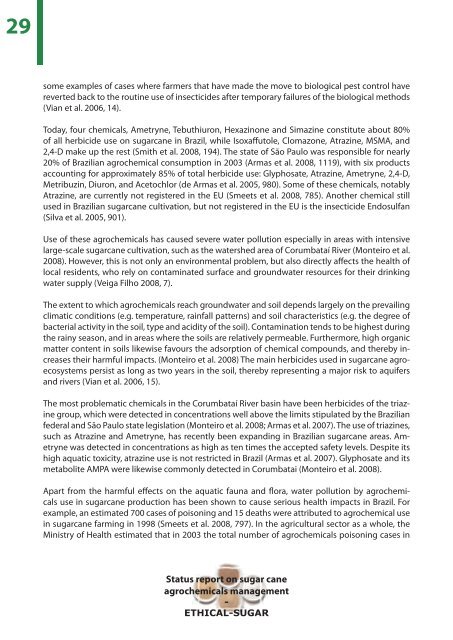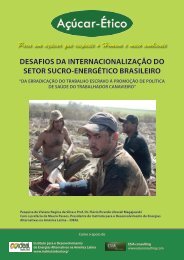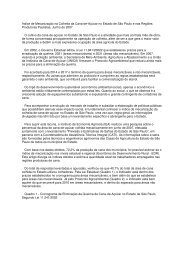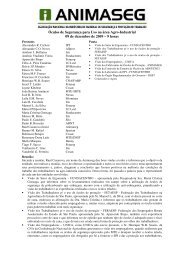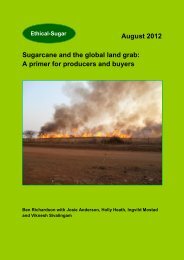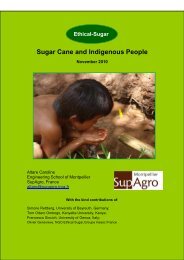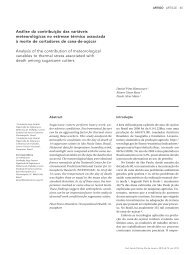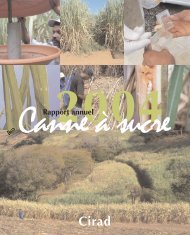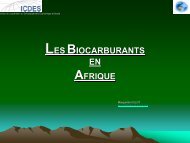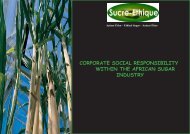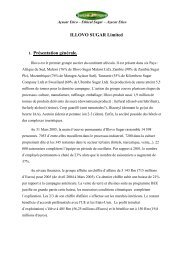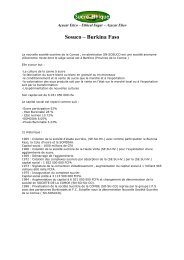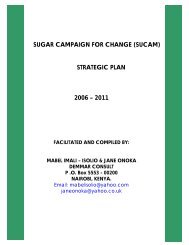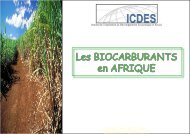Status report on sugar cane agrochemicals ... - Sucre Ethique
Status report on sugar cane agrochemicals ... - Sucre Ethique
Status report on sugar cane agrochemicals ... - Sucre Ethique
You also want an ePaper? Increase the reach of your titles
YUMPU automatically turns print PDFs into web optimized ePapers that Google loves.
29<br />
some examples of cases where farmers that have made the move to biological pest c<strong>on</strong>trol have<br />
reverted back to the routine use of insecticides after temporary failures of the biological methods<br />
(Vian et al. 2006, 14).<br />
Today, four chemicals, Ametryne, Tebuthiur<strong>on</strong>, Hexazin<strong>on</strong>e and Simazine c<strong>on</strong>stitute about 80%<br />
of all herbicide use <strong>on</strong> <strong>sugar</strong><strong>cane</strong> in Brazil, while Isoxa� utole, Clomaz<strong>on</strong>e, Atrazine, MSMA, and<br />
2,4-D make up the rest (Smith et al. 2008, 194). The state of São Paulo was resp<strong>on</strong>sible for nearly<br />
20% of Brazilian agrochemical c<strong>on</strong>sumpti<strong>on</strong> in 2003 (Armas et al. 2008, 1119), with six products<br />
accounting for approximately 85% of total herbicide use: Glyphosate, Atrazine, Ametryne, 2,4-D,<br />
Metribuzin, Diur<strong>on</strong>, and Acetochlor (de Armas et al. 2005, 980). Some of these chemicals, notably<br />
Atrazine, are currently not registered in the EU (Smeets et al. 2008, 785). Another chemical still<br />
used in Brazilian <strong>sugar</strong><strong>cane</strong> cultivati<strong>on</strong>, but not registered in the EU is the insecticide Endosulfan<br />
(Silva et al. 2005, 901).<br />
Use of these <strong>agrochemicals</strong> has caused severe water polluti<strong>on</strong> especially in areas with intensive<br />
large-scale <strong>sugar</strong><strong>cane</strong> cultivati<strong>on</strong>, such as the watershed area of Corumbataí River (M<strong>on</strong>teiro et al.<br />
2008). However, this is not <strong>on</strong>ly an envir<strong>on</strong>mental problem, but also directly a� ects the health of<br />
local residents, who rely <strong>on</strong> c<strong>on</strong>taminated surface and groundwater resources for their drinking<br />
water supply (Veiga Filho 2008, 7).<br />
The extent to which <strong>agrochemicals</strong> reach groundwater and soil depends largely <strong>on</strong> the prevailing<br />
climatic c<strong>on</strong>diti<strong>on</strong>s (e.g. temperature, rainfall patterns) and soil characteristics (e.g. the degree of<br />
bacterial activity in the soil, type and acidity of the soil). C<strong>on</strong>taminati<strong>on</strong> tends to be highest during<br />
the rainy seas<strong>on</strong>, and in areas where the soils are relatively permeable. Furthermore, high organic<br />
matter c<strong>on</strong>tent in soils likewise favours the adsorpti<strong>on</strong> of chemical compounds, and thereby increases<br />
their harmful impacts. (M<strong>on</strong>teiro et al. 2008) The main herbicides used in <strong>sugar</strong><strong>cane</strong> agroecosystems<br />
persist as l<strong>on</strong>g as two years in the soil, thereby representing a major risk to aquifers<br />
and rivers (Vian et al. 2006, 15).<br />
The most problematic chemicals in the Corumbataí River basin have been herbicides of the triazine<br />
group, which were detected in c<strong>on</strong>centrati<strong>on</strong>s well above the limits stipulated by the Brazilian<br />
federal and São Paulo state legislati<strong>on</strong> (M<strong>on</strong>teiro et al. 2008; Armas et al. 2007). The use of triazines,<br />
such as Atrazine and Ametryne, has recently been expanding in Brazilian <strong>sugar</strong><strong>cane</strong> areas. Ametryne<br />
was detected in c<strong>on</strong>centrati<strong>on</strong>s as high as ten times the accepted safety levels. Despite its<br />
high aquatic toxicity, atrazine use is not restricted in Brazil (Armas et al. 2007). Glyphosate and its<br />
metabolite AMPA were likewise comm<strong>on</strong>ly detected in Corumbatai (M<strong>on</strong>teiro et al. 2008).<br />
Apart from the harmful e� ects <strong>on</strong> the aquatic fauna and � ora, water polluti<strong>on</strong> by <strong>agrochemicals</strong><br />
use in <strong>sugar</strong><strong>cane</strong> producti<strong>on</strong> has been shown to cause serious health impacts in Brazil. For<br />
example, an estimated 700 cases of pois<strong>on</strong>ing and 15 deaths were attributed to agrochemical use<br />
in <strong>sugar</strong><strong>cane</strong> farming in 1998 (Smeets et al. 2008, 797). In the agricultural sector as a whole, the<br />
Ministry of Health estimated that in 2003 the total number of <strong>agrochemicals</strong> pois<strong>on</strong>ing cases in<br />
<str<strong>on</strong>g>Status</str<strong>on</strong>g> <str<strong>on</strong>g>report</str<strong>on</strong>g> <strong>on</strong> <strong>sugar</strong> <strong>cane</strong><br />
<strong>agrochemicals</strong> management<br />
-<br />
ETHICAL-SUGAR


